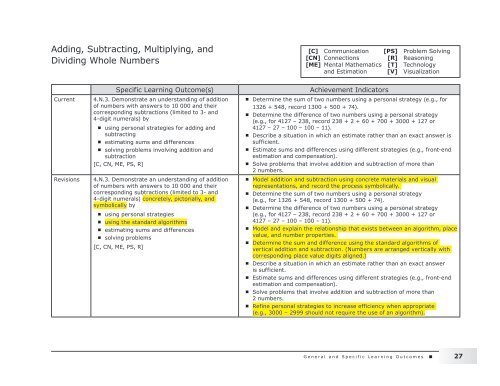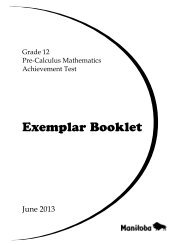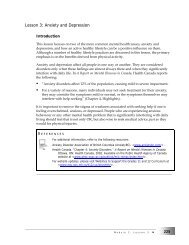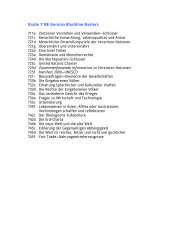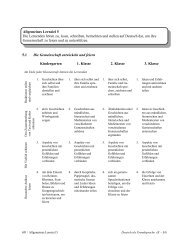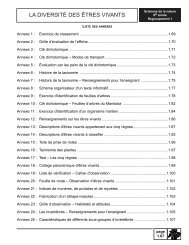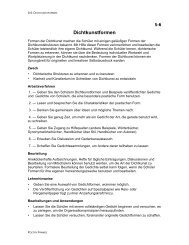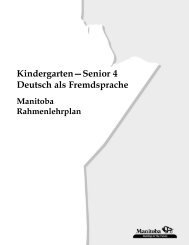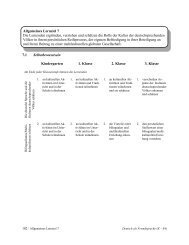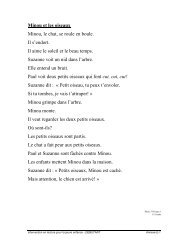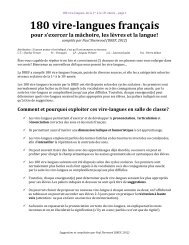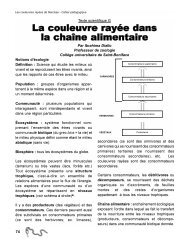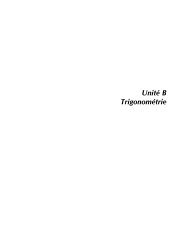Adding, Subtracting, Multiplying, and Dividing Whole Numbers
Adding, Subtracting, Multiplying, and Dividing Whole Numbers
Adding, Subtracting, Multiplying, and Dividing Whole Numbers
Create successful ePaper yourself
Turn your PDF publications into a flip-book with our unique Google optimized e-Paper software.
<strong>Adding</strong>, <strong>Subtracting</strong>, <strong>Multiplying</strong>, <strong>and</strong><br />
<strong>Dividing</strong> <strong>Whole</strong> <strong>Numbers</strong><br />
[C] Communication [PS] Problem Solving<br />
[CN] Connections [R] Reasoning<br />
[ME] Mental Mathematics [T] Technology<br />
<strong>and</strong> Estimation [V] Visualization<br />
Current<br />
Revisions<br />
Specific Learning Outcome(s)<br />
4.N.3. Demonstrate an underst<strong>and</strong>ing of addition<br />
of numbers with answers to 10 000 <strong>and</strong> their<br />
corresponding subtractions (limited to 3- <strong>and</strong><br />
4-digit numerals) by<br />
QQ<br />
QQ<br />
QQ<br />
using personal strategies for adding <strong>and</strong><br />
subtracting<br />
estimating sums <strong>and</strong> differences<br />
solving problems involving addition <strong>and</strong><br />
subtraction<br />
[C, CN, ME, PS, R]<br />
4.N.3. Demonstrate an underst<strong>and</strong>ing of addition<br />
of numbers with answers to 10 000 <strong>and</strong> their<br />
corresponding subtractions (limited to 3- <strong>and</strong><br />
4-digit numerals) concretely, pictorially, <strong>and</strong><br />
symbolically by<br />
QQ<br />
using personal strategies<br />
QQ<br />
using the st<strong>and</strong>ard algorithms<br />
QQ<br />
estimating sums <strong>and</strong> differences<br />
QQ<br />
solving problems<br />
[C, CN, ME, PS, R]<br />
QQ<br />
QQ<br />
QQ<br />
QQ<br />
QQ<br />
QQ<br />
QQ<br />
QQ<br />
QQ<br />
QQ<br />
QQ<br />
QQ<br />
QQ<br />
QQ<br />
Achievement Indicators<br />
Determine the sum of two numbers using a personal strategy (e.g., for<br />
1326 + 548, record 1300 + 500 + 74).<br />
Determine the difference of two numbers using a personal strategy<br />
(e.g., for 4127 – 238, record 238 + 2 + 60 + 700 + 3000 + 127 or<br />
4127 – 27 – 100 – 100 – 11).<br />
Describe a situation in which an estimate rather than an exact answer is<br />
sufficient.<br />
Estimate sums <strong>and</strong> differences using different strategies (e.g., front-end<br />
estimation <strong>and</strong> compensation).<br />
Solve problems that involve addition <strong>and</strong> subtraction of more than<br />
2 numbers.<br />
Model addition <strong>and</strong> subtraction using concrete materials <strong>and</strong> visual<br />
representations, <strong>and</strong> record the process symbolically.<br />
Determine the sum of two numbers using a personal strategy<br />
(e.g., for 1326 + 548, record 1300 + 500 + 74).<br />
Determine the difference of two numbers using a personal strategy<br />
(e.g., for 4127 – 238, record 238 + 2 + 60 + 700 + 3000 + 127 or<br />
4127 – 27 – 100 – 100 – 11).<br />
Model <strong>and</strong> explain the relationship that exists between an algorithm, place<br />
value, <strong>and</strong> number properties.<br />
Determine the sum <strong>and</strong> difference using the st<strong>and</strong>ard algorithms of<br />
vertical addition <strong>and</strong> subtraction. (<strong>Numbers</strong> are arranged vertically with<br />
corresponding place value digits aligned.)<br />
Describe a situation in which an estimate rather than an exact answer<br />
is sufficient.<br />
Estimate sums <strong>and</strong> differences using different strategies (e.g., front-end<br />
estimation <strong>and</strong> compensation).<br />
Solve problems that involve addition <strong>and</strong> subtraction of more than<br />
2 numbers.<br />
Refine personal strategies to increase efficiency when appropriate<br />
(e.g., 3000 – 2999 should not require the use of an algorithm).<br />
General <strong>and</strong> Specific Learning Outcomes 27
<strong>Adding</strong>, <strong>Subtracting</strong>, <strong>Multiplying</strong>, <strong>and</strong><br />
<strong>Dividing</strong> <strong>Whole</strong> <strong>Numbers</strong> (continued)<br />
[C] Communication [PS] Problem Solving<br />
[CN] Connections [R] Reasoning<br />
[ME] Mental Mathematics [T] Technology<br />
<strong>and</strong> Estimation [V] Visualization<br />
Current<br />
Revisions<br />
Specific Learning Outcome(s)<br />
5.N.5. Demonstrate an underst<strong>and</strong>ing of<br />
multiplication (2-digit numerals by 2-digit<br />
numerals) to solve problems.<br />
[C, CN, PS, V]<br />
5.N.5. Demonstrate an underst<strong>and</strong>ing of<br />
multiplication (1- <strong>and</strong> 2-digit multipliers <strong>and</strong> up to<br />
4-digit multiplic<strong>and</strong>s) concretely, pictorially, <strong>and</strong><br />
symbolically by<br />
QQ<br />
using personal strategies<br />
QQ<br />
using the st<strong>and</strong>ard algorithm<br />
QQ<br />
estimating products<br />
to solve problems.<br />
[C, CN, ME, PS, V]<br />
QQ<br />
QQ<br />
QQ<br />
QQ<br />
QQ<br />
QQ<br />
QQ<br />
QQ<br />
QQ<br />
QQ<br />
QQ<br />
QQ<br />
QQ<br />
Achievement Indicators<br />
Illustrate partial products in exp<strong>and</strong>ed notation for both factors [e.g., for<br />
36 × 42, determine the partial products for (30 + 6) × (40 + 2)].<br />
Represent both 2-digit factors in exp<strong>and</strong>ed notation to illustrate the<br />
distributive property [e.g., to determine the partial products of 36 × 42,<br />
(30 + 6) × (40 + 2) = 30 × 40 + 30 × 2 + 6 × 40 + 6 × 2 = 1200 + 60 +<br />
240 + 12 = 1512].<br />
Model the steps for multiplying 2-digit factors using an array <strong>and</strong> base-10<br />
blocks, <strong>and</strong> record the process symbolically.<br />
Describe a solution procedure for determining the product of two 2-digit<br />
factors using a pictorial representation, such as an area model.<br />
Solve a multiplication problem in context using personal strategies, <strong>and</strong><br />
record the process.<br />
Illustrate partial products in exp<strong>and</strong>ed notation for both factors [e.g., for<br />
36 × 42, determine the partial products for (30 + 6) × (40 + 2)].<br />
Represent both 2-digit factors in exp<strong>and</strong>ed notation to illustrate the<br />
distributive property [e.g., to determine the partial products of 36 × 42,<br />
(30 + 6) × (40 + 2) = 30 × 40 + 30 × 2 + 6 × 40 + 6 × 2 = 1200 + 60 +<br />
240 + 12 = 1512].<br />
Model the steps for multiplying 2-digit factors using an array <strong>and</strong><br />
base-10 blocks, <strong>and</strong> record the process symbolically.<br />
Describe a solution procedure for determining the product of two 2-digit<br />
factors using a pictorial representation, such as an area model.<br />
Model <strong>and</strong> explain the relationship that exists between an algorithm,<br />
place value, <strong>and</strong> number properties.<br />
Determine products using the st<strong>and</strong>ard algorithm of vertical<br />
multiplication. (<strong>Numbers</strong> arranged vertically <strong>and</strong> multiplied using single<br />
digits which are added to form a final product.)<br />
Solve a multiplication problem in context using personal strategies,<br />
<strong>and</strong> record the process.<br />
Refine personal strategies such as mental math strategies to increase<br />
efficiency when appropriate (e.g., 16 x 25 think 4 x (4x 25) = 400).<br />
28<br />
Revisions to the Kindergarten to Grade 8 Mathematics Curriculum Framework
<strong>Adding</strong>, <strong>Subtracting</strong>, <strong>Multiplying</strong>, <strong>and</strong><br />
<strong>Dividing</strong> <strong>Whole</strong> <strong>Numbers</strong> (continued)<br />
[C] Communication [PS] Problem Solving<br />
[CN] Connections [R] Reasoning<br />
[ME] Mental Mathematics [T] Technology<br />
<strong>and</strong> Estimation [V] Visualization<br />
Current<br />
Revisions<br />
Specific Learning Outcome(s)<br />
5.N.6. Demonstrate an underst<strong>and</strong>ing of division<br />
(3-digit numerals by 1-digit numerals) with<br />
<strong>and</strong> without concrete materials, <strong>and</strong> interpret<br />
remainders to solve problems.<br />
[C, CN, PS]<br />
5.N.6. Demonstrate an underst<strong>and</strong>ing of division<br />
(1- <strong>and</strong> 2-digit divisors <strong>and</strong> up to 4-digit dividends)<br />
concretely, pictorially, <strong>and</strong> symbolically <strong>and</strong><br />
interpret remainders by<br />
QQ<br />
using personal strategies<br />
QQ<br />
using the st<strong>and</strong>ard algorithm<br />
QQ<br />
estimating quotients<br />
to solve problems.<br />
[C, CN, ME, PS]<br />
QQ<br />
QQ<br />
QQ<br />
QQ<br />
QQ<br />
QQ<br />
QQ<br />
QQ<br />
QQ<br />
Achievement Indicators<br />
Model the division process as equal sharing using base-10 blocks, <strong>and</strong><br />
record it symbolically.<br />
Explain that the interpretation of a remainder depends on the context:<br />
QQ<br />
ignore the remainder (e.g., making teams of 4 from 22 people)<br />
QQ<br />
QQ<br />
QQ<br />
round up the quotient (e.g., the number of five passenger cars required<br />
to transport 13 people)<br />
express remainders as fractions (e.g., five apples shared by two<br />
people)<br />
express remainders as decimals (e.g., measurement or money)<br />
Solve a division problem in context using personal strategies, <strong>and</strong> record<br />
the process.<br />
Model the division process as equal sharing using base-10 blocks, <strong>and</strong><br />
record it symbolically.<br />
Explain that the interpretation of a remainder depends on the context:<br />
QQ<br />
ignore the remainder (e.g., making teams of 4 from 22 people)<br />
QQ<br />
QQ<br />
QQ<br />
round up the quotient (e.g., the number of five passenger cars required<br />
to transport 13 people)<br />
express remainders as fractions (e.g., five apples shared by two<br />
people)<br />
express remainders as decimals (e.g., measurement or money)<br />
Model <strong>and</strong> explain the relationship that exists between an algorithm,<br />
place value, <strong>and</strong> number properties.<br />
Determine quotients using the st<strong>and</strong>ard algorithm of long division. (The<br />
multiples of the divisor are subtracted from the dividend.)<br />
Solve a division problem in context using personal strategies, <strong>and</strong> record<br />
the process.<br />
Refine personal strategies such as mental math strategies to increase<br />
efficiency when appropriate (e.g., 860 ÷ 2 think 86 ÷ 2 = 43 then<br />
860 ÷ 2 is 430).<br />
General <strong>and</strong> Specific Learning Outcomes 29


